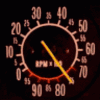Think about this: at 7000rpms the circumference of a 6" diameter crankshaft will be travelling at around 120mph.
We all know that an object with tapered leading and trailing edges - like a wing or a ships hull - travelling at that speed will have less drag than a blunt, block shaped object. It makes sense; a smooth tapered shape will disrupt the surrounding fluid much less and cause much less turbulence and therefore create much less drag.
But we also know that the above applies only if the surrounding fluid is fairly calm and the relative flow past the object is largely laminar. If the flow is already turbulent then pretty much all the advantages of an aerodynamic shape go out the window.
How would you describe the air that immediately surrounds a crank and rods thrashing at 7000rpm, with pistons pumping the crankcase air at the same rate? A picture of tranquillity?
Now, I'm well aware that there are good gains to be had from keeping the oil away from the crank. I just can't see slicking up the crank cheeks achieving much. I think you'd gain much more with crankcase vacuum - not only would you manage the oil wrap problem but you'd also reduce the air drag. And without all the filthy work involved in shaping a cast iron crankshaft.
Ok theres no doubting that all this theory makes sense but how do you deal with the fact that an identical lightweight crank /balancer engine will out acelerate and be more responsive than a heavy crank engine .Ive built both and seen it for myself over and over in street cars and racing . The amount that is removed and where it is removed has come about from hard work and testing.
Im not about to tell people what to do but the facts speak for themselves .







 View Garage
View Garage












